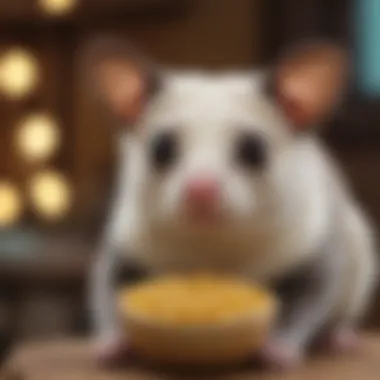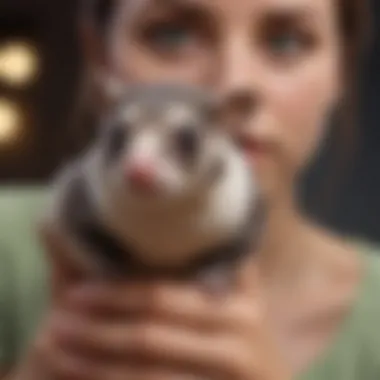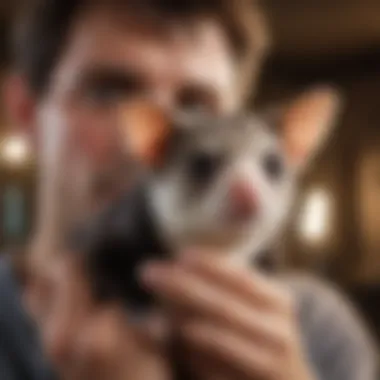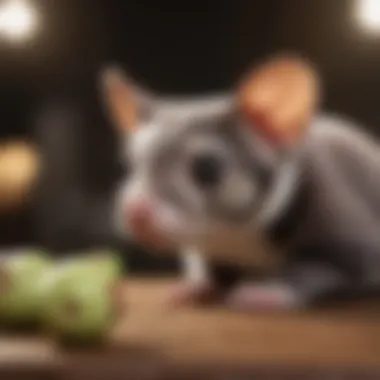Where to Buy a Sugar Glider: A Comprehensive Guide


Intro
Sugar gliders are becoming increasingly popular as pets due to their unique charm and affectionate nature. These small marsupials require specific care and environments to thrive. Understanding where to acquire a sugar glider involves not just locating a supplier, but also evaluating the ethics of your choices and grasping the responsibilities that come with ownership. This section aims to provide insights and perspectives that span beyond mere purchase options, incorporating vital knowledge about what proper care entails for a sugar glider's long-term well-being.
Care Tips
Daily Care Routines
Engaging with a sugar glider daily is essential for building trust and ensuring their emotional well-being. These marsupials are nocturnal, which means their most active times are during the evening and night. Daily interaction might include out-of-cage time for play, bonding sessions, and gentle handling. Keeping a consistent routine can help relieve stress for both you and your pet.
Cage Setup and Maintenance
A well-designed cage is crucial for a sugar glider's safety and happiness. When choosing a cage, consider one that has ample space for climbing and playing. The typical minimum size should be 2 feet wide, 3 feet deep, and 4 feet tall, allowing room for activity.
- Essentials for Cage Setup:
- Nesting box for sleep optimality
- Hammocks or fleece liners for comfort
- Suitable toys for engagement
Ensure the cage is cleaned regularly. A mix of water and mild dish soap can be used to cleanse perches and hideouts, which need to be done at least once a week.
Hygiene and Cleaning Practices
Maintaining hygiene is pivotal for the health of your sugar glider. Spot clean daily to remove droppings or uneaten food. Equip for daily upkeep with wipes made safe for animals and extra bedding materials to ensure a clean environment. Additionally, wash food and water dishes to prevent algal growth.
Seasonal Care Adjustments
In colder months, provide additional warmth through heating pads or blankets. During warmer months, ensure adequate ventilation to maintain comfort. Consider adjusting housing placement based on season changes as well to protect your glider from extreme temperatures.
Nutritional Guides
A balanced diet is at the heart of a sugar glider's overall health. Understanding their nutritional needs is vital for pet owners.
Essential Diet Components
- Fresh fruits, like apple slices and blueberries
- Quality high-protein pellets designed for marsupials
- Insects, such as mealworms or crickets for protein
- Leafy greens for engrossed hydration
Safe and Toxic Foods
While many fruits are beneficial, some are harmful. Items like avocado, chocolate, and caffeine should never be given. Always validate new food's safety before introducing them to your pet's diet.
Supplements and Treats
Calcium and multivitamin supplements can ensure your pet receives necessary nutrients. Occasional treats like yogurt drops can be positive, but moderation is key to prevent obesity.
Feeding Strategies for Different Species
Variations exist based on age and species. For instance, newborns require more protein, while older sugar gliders may need a diet balanced with specific fibers to ease digestion. Adjust their meals accordingly for their developmental stage.
Wellness and Health
Caring for a sugar glider goes hand in hand with ensuring their health. Regular check-ups and observation symptoms should form a standard practice.
Routine Health Checkups
A professional vet with experience in exotic pets is critical for these check-ups. Look for symptoms of typical sugar glider health concerns like dental issues or obesity.
Identifying Symptoms of Illness
Be observant. If your sugar glider appears lethargic, has poor coat condition, or changes weight drastically, these could indicate illness.
Preventative Care and Vaccinations
Regular vaccinations may not be standard for sugar gliders, but in some cases, treatments for parasites would be necessary. Consult your vet to tailor preventative care suitable for your situation.
Mental and Emotional Well-being
A stressed sugar glider can show aggressive behavior. Space, interaction, and toys play significant roles in their emotional state. Ensure adequate environmental enhancements align with their instincts.


Enriching Activities
Toys and varied activities can help your sugar glider remain engaged and stimulated.
Toys and Playtime Ideas
Utilize safe, dense toys made from natural materials and arrange frequent interactive play episodes to showcase their energy.
Training and Tricks
Teach basic commands and tricks to stimulate their mental growth. Reinforce learning with treats, fostering a stable bond between you and your pet.
Outdoor Activities and Interaction
If safe and supervised, letting your sugar glider enjoy the outdoors can be beneficial. A contained environment ensures safety during exploration.
DIY Projects for Mental Stimulation
Simple projects like tunnels made from cardboard or explore trees will keep them interactive and proactive.
Remember, each sugar glider has unique traits. Furthering research and using community insights can help you learn more about care nuances that fit your specific situation.
Understanding Sugar Gliders
Understanding sugar gliders is crucial for anyone considering adopting these unique animals as pets. Before purchasing a sugar glider, it is imperative to familiarize oneself with their origins, behaviors, and care requirements. This not only helps in making an informed choice but also ensures that future owners can provide a suitable environment for their new companion. A well-informed decision aids in ensuring the longevity and happiness of the pet.
What are Sugar Gliders?
Sugar gliders are small, nocturnal marsupials native to Australia, New Guinea, and surrounding islands. They belong to the family Petauridae and have adapted remarkably to life in trees, displaying remarkable gliding abilities. This gliding capability is due to their special membrane called the patagium, which stretches from their wrists down to their ankles. When leaping from tree to tree, they extend their limbs, allowing them to soar gracefully.
Understanding these animals' wild habitat can help in replicating their needs at home. It is essential to recognize that sugar gliders thrive in interactive environments. Their social nature means they often require companionship. They can bond deeply with their owners but may also need interaction with other gliders to fulfill natural instincts.
Key Characteristics
Sugar gliders are characterized by their unique physical and behavioral traits. Attorney that special features include:
- Size: Generally, sugar gliders weigh about 4 to 5 ounces and reach a length of 5 to 6 inches, with a tail that can be equally long.
- Coat Color: They display a grayish-brown coat with a white underbelly. Some breeders may offer color variations such as leucistic (white) or caramel sugar gliders.
- Lifespan: In captivity, they can live up to 10 to 15 years provided they receive proper care.
- Diet: Their diet in the wild consists mainly of nectar, fruits, and insects, making a balanced diet pivotal for their health in captivity.
These physical and dietary characteristics need to be kept in mind when considering housing and feeding them as pets.
Why Are They Popular Pets?
Sugar gliders have gained popularity in recent years due to several key factors. Enthusiasts admire their playful nature and leagues of cuteness. Sugar gliders have a friendly demeanor and can bond well with attentive owners. Additionally:
- Social Creatures: They tend to thrive in social settings, making them suitable companions for individuals or families, provided they have enough interaction.
- Space Requirements: Given their small size, sugar gliders are ideal for people who might not have much space. They do well in cages that allow climbing and gliding, making apy an effective choice for apartment living.
- Active Lifestyle: Their nocturnal nature suits those who may spend their days occupied but still want an interactive pet in the evenings.
Considering the decision to own a sugar glider involves understanding their needs and ensuring one can meet those needs adequately.
Potential Sources for Purchase
Understanding the potential sources for purchasing sugar gliders is vital for any aspiring pet owner. The choice of source can significantly impact the health and wellbeing of the animal. Different sellers vary in terms of credibility, care practices, and the customer experience they offer. Being aware of where to buy a sugar glider ensures that the pet owner makes an informed decision that aligns with their values and the sugar glider's needs.
Pet Stores
Pet stores commonly sell a variety of small animals, including sugar gliders. It is essential to evaluate the reputation of the particular store before a purchase is made. Many pet stores have established procedures to ensure the animals' health, but not all do.
- Advantages: You can physically inspect the animal and observe its living conditions. Furthermore, these stores often provide necessary supplies along with the purchase.
- Considerations: Be cautious as some larger chains may source their animals from breeders who do not adhere to rigorous welfare standards. Ask specific questions about the source of their sugar gliders and notice how responsive the staff are to your inquiries.
Licensed Breeders
Purchasing a sugar glider from a licensed breeder can often be a more reliable option than a typical pet store. Licensed breeders tend to have greater in depth knowledge about their animals. This helps ensure that the sugar gliders are of good health and optimal temperament.
- Benefits: A licensed breeder offers assurance of their breeding practices and tends to socializes their animals more effectively. You are likely to get a more detailed health history and care advice from them.
- Drawbacks: The initial cost may be higher than pet stores, yet it often follows through with long-term benefits like better health and adaptability of the animal.
Rescue Organizations
Adopting from rescue organizations is not only compassionate but also helps fill a significant need within the pet community. Many sugar gliders end up in rescues due to abandonment or unsuitable living conditions.
- Merits: Adopting from a rescue can allow you to save a life and avoid supporting commercial breeding practices. Many rescue organizations also provide veterinary care, socialization, and screening for behaviors, making the transition to a new home more manageable.
- Challenges: The availability of sugar gliders at these organizations can be inconsistent; prospective owners should be prepared for potential wait times.


Online Marketplaces
The internet has become a common venue for purchasing sugar gliders, with platforms dedicated to pet sales. However, finding reliable sellers is a key aspect in this process. Searching broadly can yield various options but testing legitimacy becomes vital, as regulations may be less strict online.
- Pros: The primary advantage is access to a wider range of animals, including breeds not commonly found in local stores. The convenience of remote buying is a factor for many.
- Cons: This option carries a higher risk regarding the health and socialization of the animal. Always lookup reviews and past transaction histories where possible, and ensure that sellers can provide health clearance documents for the sugar glider.
Criteria for Selection
Selecting a sugar glider involves careful consideration. The choices you make can directly impact the quality of life of these unique pets. Understanding the criteria for selection ensures that you choose a reliable source where the animals are bred responsibly.
Reputation of the Seller
The reputation of the seller is paramount when acquiring a sugar glider. A respected seller often means better overall care and quality of animals. Engaging with trusted breeders or stores can prevent unfortunate experiences. To check a seller's reputation, you can follow several steps:
- Online Reviews: Websites such as Reddit often have discussions about different sellers. Reading what past buyers say can provide insight into others' experiences.
- Social Media Feedback: Facebook groups focused on sugar gliders can also inform potential buyers. Members often share recommendations and warnings about different sellers.
- Certifications: Check if the seller has any certifications or affiliations with reputable pet organizations. This may signify a commitment to ethical breeding practices.
Understanding who you are buying from plays a crucial role in ensuring the animal's well-being before it even comes home to you.
Health Assurance
Health assurance is a significant factor in the purchase process. Buying from a source that guarantees health can safeguard you against many potential health issues in newborn sugar gliders. Importantly, look for specific assurances:
- Health Records: A good seller should provide documentation regarding vaccinations and health checks. This not only fulfills regulations but also ensures that each sugar glider is in good health prior to sale.
- Veterinary Care Access: Check whether the seller is willing to assist in facilitating veterinary care pieces in case of illness. Knowledgeable breeders often are responsible for maintaining their pets' health even after sale.
- Returning Policy: A clear return policy if the animal exhibits health problems shortly after purchase signals the seller's confidence in selling healthy sugar gliders.
Healthcare management of sugar gliders can preempt issues that could arise otherwise, enhancing both owner satisfaction and animal well-being.
Socialization and Upbringing
Socialization and upbringing practices matter greatly in the type of sugar glider your home will gain. Animals kept in an environment focused on their social needs will be easier to acclimate and bond with their new owner. Key factors regarding socialization to consider encompass:
- Breeding Practices: Responsible breeders prioritize social interaction. In cases where sugar gliders are hand-raised with human interactions, it may lead to sugars that are friendlier and more accustomed to human contact.
- Environmental Stimuli: Sellers should maintain clean legible cages enriched with toys and other social stimuli. This evidence indicates that animal welfare is a consideration in their practice.
- Observed Behavior: When visiting a prospective seller, look for signs of healthy social behavior among sugar gliders in their care. Animals playing together can be an indicator of positive upbring.
A well socialized sugar glider significantly adds to the living experience with this pet. Positive experiences from a responsible seller can assure that owners begin their journey with healthy, interactable pets.
Costs Involved
Understanding the costs associated with acquiring a sugar glider is crucial for anyone considering adding one to their family. Along with the joy and companionship these animals can bring, they also come with financial responsibilities. Ignoring these costs can lead to inadequate care and can impair the well-being of the animal. An honest assessment of both the initial and ongoing expenses sets the foundation for responsible ownership and reflects an understanding of the long-term commitment that comes with these pets.
Initial Purchase Price
The initial purchase price of a sugar glider varies significantly based on several factors, including geographical location, the seller's reputation, and peculiarities of the individual animal, such as lineage. Typically, you may find sugar gliders priced between $150 to $300 or more. Reputable breeders may command higher prices, but they often provide important assurances regarding the health and temperament of the animal.
When purchasing, buyers should examine several characteristics:
- Age: Babies may cost more than adults but are often preferable for socialization and bonding.
- Breed Variations: Certain color mutations or bloodlines may attract premium prices.
- Health Certificates: A responsible seller might offer a health guarantee which can elevate the cost.
Additionally, the purchase price might not cover all necessary supplies and equipment. Setup costs like a suitable cage, toys, and linings are essential one-time expenses that should not be overlooked. This requires potential owners to be financially prudent in their planning for initial expenditures.
Ongoing Care Expenses
The ongoing expenses of caring for a sugar glider can become substantial over time, meriting thorough consideration:
- Food Costs: Sugar gliders have specific dietary needs. A proper diet includes fruits, vegetables, and specially formulated pellets, adding to the monthly food budget, which may run high depending on your location.
- Veterinary Expenses: Sugar gliders require regular veterinary visits. Costs can rise with vaccinations, wellness checks, and, in some cases, treatments for unexpected illnesses. It's wise to set aside a portion of your budget for occasional emergency care, as the unexpected can always occur.
- Supplies Replacement: You will need to regularly replace items like bedding and toys. Natural wear and tear can affect health, making a frequent budget for updates necessary for good maintenance.
It is critical to understand the total cost involved in caring for a sugar glider extends well beyond the initial purchase.
Implementing a realistic financial plan shortly after obtaining a sugar glider will assist in avoiding reactivity during stressful times in the animal's life. As a prospective owner, evaluating ongoing care will position you for more effective management of these cute companions.
Ethical Considerations
When thinking about acquiring a sugar glider, it's crucial to understand the ethical implications tied to the decision. These small marsupials have unique demands and certain responsibilities come with owning them. Ethical considerations ultimately shape not only the welfare of the sugar glider you aims to buy but also affects wild populations and overall ecosystem health.
Impact on Wild Populations
Sugar gliders are native to parts of Australia and New Guinea. The increasing popularity of these animals as pets raises concerns about their conservation status. Unsustainable harvesting of sugar gliders from the wild for the pet trade can dangerously affect wild populations. Their habitats may be encroached upon and degraded due to growing demand.
“Conservation efforts must balance pet ownership with wild species preservation.”


Given the heightened risk of reducing their natural populations, potential buyers should avoid sources that contribute to these unsustainable practices. Ensure that your sugar glider originates from a responsible breeder or an accredited rescue organization. Supporting these entities is vital to maintaining the health and stability of sugar glider populations.
Promoting Responsible Ownership
Responsible ownership of sugar glidersinaovlves more than just purchasing them. It means committing to a lifestyle that respects their needs and recognizes their special characteristics. Educating oneself before acquiring a sugar glider makes a significant difference in creating a healthy environment for these pets.
- Education: Understanding their social needs, dietary requirements, and habitat preferences is essential. It is not only about having a sugar glider as a pet, but also about making sure that their environment mimics what they would experience in the wild as closely as possible.
- Re-homing Considerations: If someone can no longer take care of a sugar glider, it's responsible to reach out to reputable rescue organizations rather than abandoning them. These organizations foster responsible pet re-homing to underline the importance of their well-being at all stages of their lives.
- Legal Awareness: Researching local regulations about owning sugar gliders is necessary. Some regions enforce strict guidelines on their ownership. To avoid legal hassles, verify that you comply with any laws conjugated to keeping these animals.
Achieving successful and ethical ownership outcomes for sugar gliders can generate joy and satisfaction. Potential owners must prioritize the creature's quality of life to ensure both the responsibilities and pleasures of ownership are met.
Post-Purchase Responsibilities
After acquiring a sugar glider, potential owners face a critical phase: meeting the individual needs of their new furry companion. Understanding the responsibilities involved can significantly impact the quality of life for both the sugar glider and the owner. This section details essential considerations like habitat creation, dietary requirements, and consistent veterinary care.
Creating a Suitable Habitat
Designing an environment that caters to the natural behavior of sugar gliders is crucial. These animals are native to the forests of Australia and New Guinea. Thus, their habitat needs to encourage climbing, jumping, and exploring.
Here are several components to incorporate:
- A spacious cage: A multilevel cage with ample room for movement is essential. The cage should be at least 24 x 24 x 36 inches.
- Natural branches and perches: Wood ledges should imitate their natural habitat. Use untreated branches for climbing and play.
- Hiding spots: Include nests or blankets for security. Sugar gliders need privacy to feel safe.
- Toys: Puzzles and chew toys can support mental stimulation, which is vital for their emotional well-being.
Adequate sanitation is also key. Regularly clean the living space to reduce odor and prevent illness. A comfortable and secure habitat enables sugar gliders to thrive while reducing behavioral problems.
Understanding Dietary Needs
Sugar gliders have specific dietary requirements that reflect their omnivorous nature. Improper nutrition can lead to health issues. Owners must research and provide a varied diet comprised of natural foods and vitamins.
A balanced diet should include:
- Fresh fruits and vegetables: Foraging is significant to their instinctive nature. Introduce a range of fruits like apples and veggies like carrots.
- Protein sources: These can be cooked chicken, insects, or specially-formulated glider pellets.
- Sugar glider mixture: Some owners follow dietary plans, like the Leadbeater's mix, which includes eggs and honey.
Always ensure access to clean water. Regular monitoring of weight and health will help detect dietary deficiencies early.
Regular Veterinary Care
Veterinary oversight serves as a safety net for a sugar glider's long-term health. Routine check-ups allow early detection of potential health issues and provide peace of mind for owners.
Key aspects of veterinary care include:
- Annual exams: Schedule yearly visits for vaccinations and overall health assessments.
- Specialized knowledge: Ensure your veterinarian is experienced with exotic pets. Sugar gliders have unique care needs and need mindful attention.
- Dental care: Oral hygiene must not be overlooked as dental problems can arise from poor diet or lack of chewing activities.
Moreover, create a first-aid kit specifically for your sugar glider. This preparation ensures that you can respond quickly in emergency situations.
Incorporating these responsibilities enhances the life quality for sugar gliders, turning ownership into a reliable and rewarding experience.
Closure
In this article, we explored various facets of acquiring a sugar glider, contributing significant insights notably about selection criteria and ethical considerations. Understanding these points is crucial not only for potential owners but also for the well-being of the animals themselves. The health of sugar gliders does not simply hinge on their acquisition; it largely depends on the choices made from where and how they are purchased.
When summarized, this guide highlighted key sections, including:
- Various purchasing sources, providing clarity about where to find sugar gliders.
- Essential criteria for assessment to identify healthy and socialized pets.
- Detailed cost considerations for both initial purchase and ongoing care.
- Ethical implications and responsibilities that come with pet ownership.
The nice aspects are sea with responsible care, resulting in enhanced living conditions for the pets.
Understanding these issues assures both emotional and practical benefits for aspiring sugar glider parents. Beyond just a willingness to provide a home, informed decision-making breeds connoisseurs of compassion who support pro pet practices.
Summarizing Key Points
Sugar gliders are unique pets that require notable attention and prudent selection when acquiring them. This article offered an outline of purchasing options with emphasis placed on responsible sourcing—whether it comes from pet stores, licensed breeders, rescue organizations, or online channels.
It is of high priority to evaluate each option considering:
- Seller reputation to ensure legitimacy
- Health status of the animal to prevent unexpected veterinary issues
- Proper socialization that supports satisfactory animal behavior
Investing time in this process ultimately ensures an enriching experience for both pet owner and the animal itself. Getting quality knowledge lays groundwork for nurturing bonds that transcend mere ownership.
Encouraging Informed Choices
Informed choices hinge on a deep understanding of several cornerstones introduced throughout this article. Providing the right habitat, maintaining suitable feeding practices, and attending to regular veterinary needs all converge towards a thriving home for sugar gliders.
Potential owners bear responsibilities far beyond financial implications. Importantly, sustaining healthy wildlife populations whilst promoting ethical ownership creates a systematic framework whereby pets are seen not just as companions but rather as living beings deserving mindfulness.
Investigating options for purchase demands thorough examination with references from each suggested platform, and prioritizing animals acquired under ethical pretense can shape future practices in this expanding pet community.















